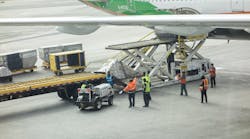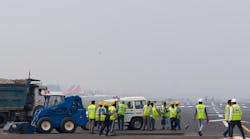Rehabilitating aging runways is not only important to the safety of passengers and aircraft, but also to the entire operation of an airport. Capacity at airports is dependent on upgraded terminals, as well as on the surrounding infrastructure, including runways, to keep pace with increases in overall flight operations.
There are several important factors that designers must consider for every airport runway project to ensure the process is comprehensive, efficient and cost-effective, including:
- Preliminary engineering studies
- Communication and coordination with the airport and its stakeholders
- Innovation
Preliminary engineering. When conducting a preliminary study on a runway rehabilitation or reconstruction project, there are some basic questions that need to be answered:
- Who are the key stakeholders?
- What are the rehabilitation options?
- Are there additional improvements that need to be made while the runway is closed?
- What is the best construction phasing option for the airport?
Identifying key stakeholders up front helps in the development of a project schedule so appropriate coordination can occur between all parties and solutions can be developed that work to achieve the project’s goals. While this process takes time, it can help to avoid additional cost and delays in the future by vetting alternatives and solutions prior to final design and construction. Working transparently and collaboratively with stakeholders develops trust and allows the airport to provide consistent and reliable messaging throughout the project.
A good preliminary study will help determine the condition of the existing pavement to evaluate all the rehabilitation options as well as the infrastructure beneath and around the runway, such as lighting, utilities, or drainage systems. Since runways are rarely closed, it’s a great opportunity to address these items during a planned runway closure to avoid future disruptions to airport operations. The study should evaluate all reconstruction/rehabilitation options for not only initial costs and construction duration, but also life cycle costs, impacts to approaches, long term maintenance requirements, and constructability/quality.
Developing a realistic phasing plan early in the design process is important because it can have impacts to construction costs, overall project duration, and environmental review requirements. The phasing plan should be developed closely with stakeholders to address their needs as well as avoid surprises during construction.
Communication and coordination. Runway projects involve on-going conversations between the designer, airport, and a host of airport stakeholders, including airlines, tenants, FAA, city departments, and the general public. Designers should be mindful to collect all stakeholder’s perspectives and feedback on the alternatives being evaluated and roll this into a solution that works for all.
The biggest challenge with coordination is getting all stakeholders on the same page, so they understand the project timeline, benefits and what is being done to minimize disruptions. Having a well-defined schedule for runway closures and clearly communicating what the project benefits are can usually generate more receptivity to changes.
A joint outreach effort between the design team and airport is preferable because it helps facilitate meetings in a coordinated fashion to keep all parties informed on the project’s progress.
Communication with FAA is key. While the FAA is one single organization, in reality it has multiple lines of business that have different roles and objectives. For project teams, this means being aware of their responsibilities, what their timelines are for reviews and approvals and building that into the schedule to minimize delays and set realistic expectations for all parties involved.
Innovation. Runway rehabilitation and reconstruction projects offer airports an opportunity to evaluate their existing capacity and plan for the future. Exit taxiway geometry has a direct affect on an airport’s overall capacity. Evaluating the location of exit taxiways, forecasted growth and the fleet mix that uses the airport can assist in maximizing airport capacity by finding the optimal location for exit taxiways that reduce runway occupancy times and increase capacity. Previous FAA guidance for the location of exit taxiways was developed in 1983 and was based on generic aircraft types rather than specific aircraft to estimate exit taxiway cumulative utilization percentages.
Now, designers have access to real quantitative data collected at specific airports via Airport Surface Detection Equipment, Model X (ASDE-X) that provides information on runway occupancy times, threshold to exit taxiway distances and deceleration rates for specific aircraft. By looking at this actual data and taking into context an airport’s unique layout and terminal configurations, designers can get a clear picture of where the optimal location for exit taxiways are based on the actual fleet mix of the airport.
To achieve better, faster and more cost-effective runway rehabilitation improvements requires careful preliminary assessments and engineering, close collaboration and communication with the airport and its stakeholders, and a willingness to embrace innovations that will yield long-term efficiencies and cost savings. With continued enhancements to runway infrastructure, airports can provide a better experience for all users and ensure safety, longevity and functionality well into the future.
Lynette Mellett serves as an aviation section manager for HNTB Corporation, with 15 years of specialized experience in providing planning, engineering and construction services to airports throughout the United States. Her expertise encompasses airfield improvements, including runways, taxiways, aprons, drainage, marking and lighting, as well as performing quality control reviews on airfield related projects. She can be reached at [email protected].





